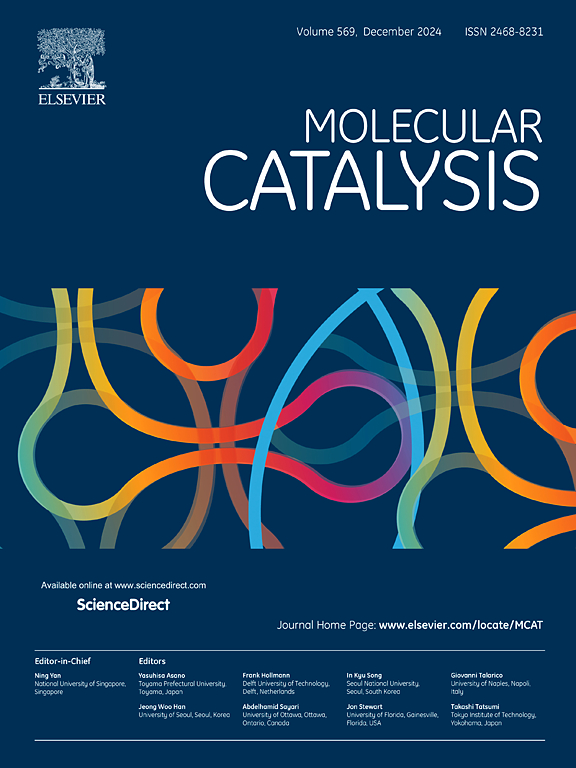花状TP-BiOI直接z -图式异质结用于可见光催化去除环境污染物
IF 3.9
2区 化学
Q2 CHEMISTRY, PHYSICAL
引用次数: 0
摘要
与传统异质结相比,直接Z-scheme异质结在有效加速光生载流子分离的同时,还能保持较强的氧化还原电位。本文报道了由三(4-氨基苯基)胺基聚酰亚胺(TP)和BiOI构建的花状直接z型异质结,并以Cr(VI)还原和罗丹明B (RhB)降解为目标反应研究了其光催化活性。在可见光下,TP-BiOI(45%)表现出良好的Cr(VI)还原性能和RhB的降解活性,Cr(VI)还原的表观速率常数为2.3207分钟(⁻¹),分别是原始TP(0.5059分钟)和BiOI(0.5364分钟)的4.6倍和4.3倍。在600 nm光照射下仍保持一定的光催化活性。这种性能的增强主要归功于直接z型异质结的形成,它显著提高了光生载流子的分离效率。此外,花状的形态增加了比表面积和活性位点的数量,进一步提高了催化性能。本研究提供了一种绿色简单的方法来制备形状独特的直接z型异质结,在可见光下去除环境污染物具有很大的前景。本文章由计算机程序翻译,如有差异,请以英文原文为准。

Flower-like TP-BiOI direct Z-scheme heterojunction for efficient visible-light photocatalytic removal of environmental pollutants
Compared with conventional heterojunctions, direct Z-scheme heterojunctions can retain strong redox potentials while effectively accelerating the separation of photogenerated charge carriers. Herein, we report a flower-like direct Z-scheme heterojunction constructed from tris(4-aminophenyl)amine-based polyimide (TP) and BiOI, and investigate its photocatalytic activity using Cr(VI) reduction and rhodamine B (RhB) degradation as the target reactions. Under visible light, TP-BiOI(45 %) exhibited excellent Cr(VI) reduction performance and RhB degradation activity, achieving an apparent rate constant of 2.3207 min⁻¹ for Cr(VI) reduction, approximately 4.6 and 4.3 times higher than those of pristine TP (0.5059 min⁻¹) and BiOI (0.5364 min⁻¹), respectively. Moreover, it still retained a certain degree of photocatalytic activity under 600 nm light irradiation. The enhanced performance is primarily attributed to the formation of the direct Z-scheme heterojunction, which significantly improves the separation efficiency of photogenerated charge carriers. Additionally, the flower-like morphology increases the specific surface area and number of active sites, further boosting catalytic performance. This study provides a green and simple method for preparing unique-shaped direct Z-scheme heterojunctions, which holds great promise for the removal of environmental pollutants under visible light.
求助全文
通过发布文献求助,成功后即可免费获取论文全文。
去求助
来源期刊

Molecular Catalysis
Chemical Engineering-Process Chemistry and Technology
CiteScore
6.90
自引率
10.90%
发文量
700
审稿时长
40 days
期刊介绍:
Molecular Catalysis publishes full papers that are original, rigorous, and scholarly contributions examining the molecular and atomic aspects of catalytic activation and reaction mechanisms. The fields covered are:
Heterogeneous catalysis including immobilized molecular catalysts
Homogeneous catalysis including organocatalysis, organometallic catalysis and biocatalysis
Photo- and electrochemistry
Theoretical aspects of catalysis analyzed by computational methods
 求助内容:
求助内容: 应助结果提醒方式:
应助结果提醒方式:


